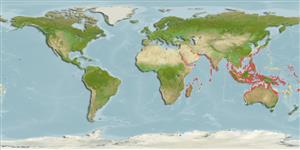>
Eupercaria/misc (Various families in series Eupercaria) >
Gerreidae (Mojarras)
Etymology: Gerres: Latin, gerres = a kind of anchovies; cited by Plinius.
Environment: milieu / climate zone / depth range / distribution range
Ecologia
marinhas; estuarina associadas(os) a recifes; intervalo de profundidade 0 - 20 m (Ref. 11441). Tropical; 36°N - 35°S, 25°E - 174°W
Indo-Pacific: Red Sea to South Africa, east to Marshall and Samoa islands; north to the Ryukyus and south to the Queensland, Australia (Great Barrier Reef) and New Caledonia.
Comprimento de primeira maturação / Tamanho / Peso / Idade
Maturity: Lm ?, range 22 - ? cm
Max length : 30.0 cm TL macho/indeterminado; (Ref. 4323); common length : 20.0 cm SL macho/indeterminado; (Ref. 37816)
Espinhos dorsais (total) : 9; Raios dorsais (total) : 10; Espinhos anais: 3; Raios anais : 7. Body silvery with 6-8 irregular, faint dusky oblique and vertical bands dorsolaterally and ventrolaterally (usually more apparent in young stressed or preserved specimens. U-shaped premaxilla groove mostly without scales (tiny scales anteriorly in specimens over 13 cm SL). Posterior margin of maxillary beyond a vertical through anterior margin of pupil. Supraneural bones 3. Spinous dorsal fin with an indistinct dusky patch (2nd-6th spines) and very narrow dusky distal margins on upper membranes between spines. Scales between 5th dorsal fin spine and lateral line 3-4, usually 3.5. Pelvic fin when fresh is semi-transparent or dull yellow color with an indistinct dusky band and dull white distal margin posteriorly (Ref. 35850); pectoral fins reaches beyond level of anus; caudal fin forked deeply and with long lobes (Ref. 90102).
Found along the coast, saltwater lagoons, and estuaries (Ref. 5213). Also in sand bottoms in sheltered waters near reefs (Ref. 90102). Occurs singly or in groups (Ref. 9710). Feeds on small organisms living on sandy bottoms. Utilized as fish meal and duck food. Sold fresh in markets.
Ciclo de vida ou comportamento de acasalamento
Maturities | Reprodução | Spawnings | Egg(s) | Fecundities | Larvas
Iwatsuki, Y., S. Kimura and T. Yoshino, 1999. Redescriptions of Gerres baconensis (Evermann & Seale, 1907), G. equulus Temminck & Schlegel, 1844 and G. oyena (Forsskål, 1775), included in the "G. oyena complex", with notes on other related species (Perciformes: Gerreidae). Ichthyol. Res. 46(4):377-395. (Ref. 35850)
Status na Lista Vermelha da UICN (Ref. 130435)
Ameaça para os humanos
Harmless
Uso pelos humanos
Pescarias: espécies comerciais
Ferramentas
Relatórios especiais
Baixar XML
Fontes da internet
Estimates based on models
Preferred temperature (Ref.
123201): 25.2 - 29.3, mean 28.5 °C (based on 3352 cells).
Índice de diversidade filogenética (Ref.
82804): PD
50 = 0.5000 [Uniqueness, from 0.5 = low to 2.0 = high].
Bayesian length-weight: a=0.01096 (0.00698 - 0.01722), b=3.09 (2.96 - 3.22), in cm total length, based on LWR estimates for this species & Genus-body shape (Ref.
93245).
Nível Trófico (Ref.
69278): 2.7 ±0.24 se; based on food items.
Generation time: 1.0 ( na - na) years. Estimated as median ln(3)/K based on 1
growth studies.
Resiliência (Ref.
120179): Elevada, tempo mínimo de duplicação da população menor que 15 meses (Preliminary K or Fecundity.).
Prior r = 1.19, 95% CL = 0.79 - 1.79, Based on 1 data-limited stock assessment.
Fishing Vulnerability (Ref.
59153): Low vulnerability (20 of 100).
Climate Vulnerability (Ref.
125649): High vulnerability (63 of 100).
Nutrients (Ref.
124155): Calcium = 85.5 [43.0, 156.5] mg/100g; Iron = 0.796 [0.382, 1.420] mg/100g; Protein = 19.4 [17.4, 21.4] %; Omega3 = 0.135 [0.074, 0.243] g/100g; Selenium = 32.4 [17.9, 64.0] μg/100g; VitaminA = 38 [10, 133] μg/100g; Zinc = 1.87 [1.23, 2.68] mg/100g (wet weight);
